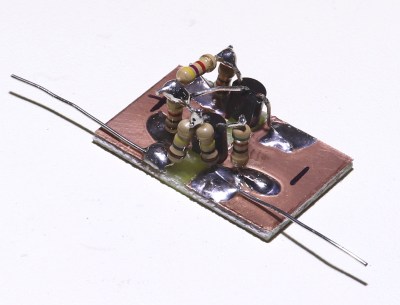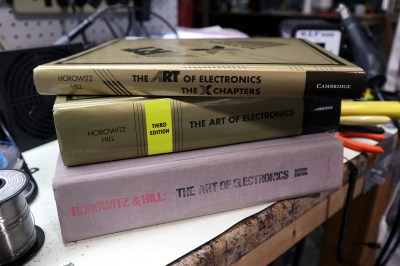Art of Electronics Chapter 1 New York City Example
If you've been into electronics for whatsoever length of fourth dimension, you've almost certainly run across the applied bible in the field, The Art of Electronics, commonly abbreviated AoE. Any fan of the volume will certainly desire to consider obtaining the latest release, The Art of Electronics: The x-Chapters, which follows the previous third edition of AoE from 2015. This new book features expanded coverage of topics from the previous editions, plus discussions of some interesting but rarely traveled areas of electric applied science.
For those unfamiliar with it, AoE, first published in 1980, is an unusually useful hybrid of textbook and engineer's reference, blending merely plenty theory with liberal doses of practical experience. With its lively tone and informal way, the volume has enabled people from many backgrounds to pattern and implement electronic circuits.
After the initial book, the second edition (AoE2) was published in 1989, and the third (AoE3) in 2015, each i renewing and expanding coverage to keep upward with the rapid pace of the field. I started with the 2nd edition and information technology was very well worn when I purchased a re-create of the third, an upgrade I would recommend to anyone still on the fence. While the 2d and tertiary books looked a lot like the first, this new one is a bit different. It's at the same time an expanded discussion of many of the topics covered in AoE3 and a self-contained reference manual on a variety of topics in electrical engineering.
I pre-ordered this book the same day I learned it was to be published, and it finally arrived this week. So, having had the volume in mitt — about continuously — for a few days, I think I've got a decent idea of what information technology'south all about. Stick effectually for my accept on the latest in this very interesting serial of books.
Overview
In the first paragraph of the book's preface, the authors give the basic picture: the "x" is for eXtra, meaning that the cloth in this volume was originally slated to be part of the AoE3, but simply didn't fit — that book is 1250 pages as information technology stands. The new book comprises some 500 pages organized into five chapters: 1x, 2x, 3x, 4x, and 9x. This unusual numbering scheme keeps the contents in correspondence with the chapters of the third edition of AoE, stressing the fact that a lot of this material would be right at habitation there. In fact, each affiliate of the new volume begins with a repetition of the terminate-of-affiliate review from the respective function of AoE3.

While I'll discuss some of the highlights of each chapter — simply non an exhaustive list — continue in mind that this book reads a little differently than AoE3: information technology's more engineering reference handbook and less textbook. The preface is explicit about this; the linear structure of previous AoE books has been replaced with very modular sections on specific topics. This is keen if you're an even somewhat experienced designer looking for some from-the-trenches experience on a specific topic, but maybe less useful for the beginner — more well-nigh that afterward.
Chapter 1x: Real-World Passive Components
Starting with the lowly wire, this chapter examines the behavior of components in the real world. Conductors, cables, and connectors are examined to determine the not-ideal effects they tin can exhibit. Also, there are discussions of real-world resistors of various types, including digital potentiometers. Capacitors and inductors get all-encompassing handling since there are myriad imperfections that plague them. Department 1x.6 is especially interesting, covering mechanical switches and relays, components that nosotros sometimes forget accept non-ideal characteristics. This is certainly worth a read if you use these components for anything non-lilliputian. Finally, the affiliate concludes with a give-and-take of unlike types of diodes, including some esoteric types, and their practical failings.

Simply there's more the simply practical in this book. As an example, the book devotes a section of a few pages to tunnel diodes, an esoteric field of study with largely nostalgic interest for the authors. Non content to simply give the theory, they delve into the practical aspects of tracing tunnel diode curves. Having documented my attempts at this in these very pages, I tin actually appreciate the care and detail that went into the treatment of this subject in the x-Capacity. This is Hackaday-type stuff; if it were't already in a book, their work would fit correct in as a daily article here. As we'll see, there'due south more of the same in subsequent chapters.
This isn't the simply fun the authors are having. The title of this very article comes from their own footnote alluding to The X Files.
Affiliate 2x: Advanced BJT Topics

As was noted, y'all won't find a textbook introduction to bipolar junction transistors hither; instead, you'll find a collection of smaller notes about specific subtopics. For instance, the authors tabulate and hash out the leakage currents of a collection of BJTs and FETs for comparison and include a section on BJT bandwidth and transition frequency. They work through a detailed case simulating several BJT amplifiers in SPICE to measure distortion. They discuss improved current mirrors and some very interesting bipolarity ones.
In that location are farther excursions into lands less traveled, like the discussion of a two-final negative resistance made from BJTs, some other obscure subject field shut to my heart.
Chapter 3x: Avant-garde FET Topics
In the third x-Chapter, yous'll find some skilful info on selecting FETs for your application, discussions of FET transconductance, the bandwidth of FET circuits (and comparisons to BJTs), a very good word of the evolution and current country of power MOSFETs, and a section on integrated MOSFET gate drivers. At that place are also application circuits for measuring MOSFET gate accuse and FET transconductance, with tabulated results for a variety of types.
Again, there'southward a smattering of awarding examples featuring FETs, including driving a piezo transducer, generating fast pulses for LEDs, quickly quenching high-energy magnetic field coils, and generating fast 1.5 kV voltage ramps.
Affiliate 4x: Advanced Topics in Operational Amplifiers
x-Chaper iv begins appropriately with a brief discussion of an antiquarian vacuum-tube op-amp, with the rest of the chapter devoted mainly to discussing the effectively points of pattern with modernistic devices. There's an expanded give-and-take of feedback stability, a detailed treatment of transresistance amplifiers, such as for photodiodes, coverage of unity-proceeds buffers and their uses, and two capacity on high-speed op-amps: one on the voltage-feedback diversity, and a second for current-feedback types. They also encompass some unusual capacitive-feedback op-amp circuits, logarithmic amplifiers, and driving capacitive loads, among other curt topics.
In the exotica category, there is a department on silicon photomultipliers, and an example circuit which produces graphs of the cluttered attractor of the Lorenz system on an oscilloscope.
Chapter 9x: Avant-garde Topics in Power Control
Hither, yous'll detect a discussion of simple diode- and MOSFET-based contrary battery protection circuits, lithium-ion bombardment circuit rubber, implementing foldback electric current limiting, controlling DC motors with PWM, high-side electric current sensing, and various other topics in power electronics design. There is a teardown and demote comparing of genuine and apocryphal iPhone chargers, and a skilful section on making temperature measurements on power circuits — from the usual finger probe to thermal cameras.
Every bit for out-of-the-way topics, at that place's i folio on low-voltage heave converters for energy harvesting — they present a simple circuit that starts upwardly at a supply voltage of 20 mV and runs down to 10 mV. They take also included a section on bus converters: bi-directional DC converters, which can convert from i voltage to another, say 12V down to 5V, but also piece of work in contrary, transparently. This is interesting stuff.
Discussion
Obviously, in this curt review, I can't embrace everything in the book. Take I left out something that will end upward being your favorite part? Quite perchance. Hopefully, though, you've got enough of the season of the book to know if it warrants a farther look.
 Like in the original AoE books, in improver to the word of design problems, the new volume contains selection tables for diverse electronic parts. Need a high-speed op-amp? How about a MOSFET gate driver? Check the corresponding table. It would exist a fault to confuse these tables with the parametric search available on manufacturer's or distributor'due south web sites. While the search tools are certainly useful, they're a poor substitute for tables advisedly curated by designers who've actually used the parts.
Like in the original AoE books, in improver to the word of design problems, the new volume contains selection tables for diverse electronic parts. Need a high-speed op-amp? How about a MOSFET gate driver? Check the corresponding table. It would exist a fault to confuse these tables with the parametric search available on manufacturer's or distributor'due south web sites. While the search tools are certainly useful, they're a poor substitute for tables advisedly curated by designers who've actually used the parts.
One of the more interesting features of the book is the parts index at the back. If you lot want to know all the authors take to say nearly the 2N3904 transistor, for instance, the alphabetize will point you lot to the twenty-2 places in the volume that it'due south mentioned. This is a tremendous idea for a book like this, which contains all sorts of information you may not detect in datasheets.
Should Yous Buy It?
First off, I should say that I don't consider whatsoever of the AoE books to be suitable equally first books for accented beginners. Sure, if you've studied some other field of engineering science, yous could probably pick up a copy and first running, but for the true beginner without whatever engineering experience, you would probably want to start elsewhere and refer to AoE for more than avant-garde discussions — sound off in the comments with beginner book recommendations if you lot have them.
However, if you've used whatsoever of the three editions of The Art of Electronics with success, I'd recommend the x-Capacity without hesitation. Having had a lilliputian flake of time with it now, I'd be tempted to say that the third edition of AoE is incomplete without this additional cloth. This is not to say that I felt AoE3 was defective before this new book, but it'south certainly more complete with this included. Does it make sense to buy this book without AoE3? Certain it's a great volume for what it covers, but the x-Chapters itself is absolutely incomplete without AoE3 by its side. Personally, I wouldn't be without either on my shelf at present.
marshallwituarmay92.blogspot.com
Source: https://hackaday.com/2020/01/23/the-truth-is-in-there-the-art-of-electronics-the-x-chapters/
0 Response to "Art of Electronics Chapter 1 New York City Example"
ارسال یک نظر